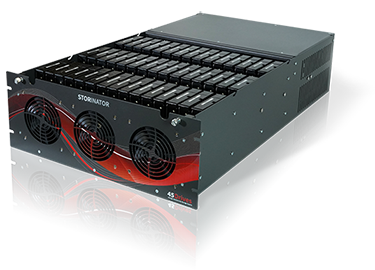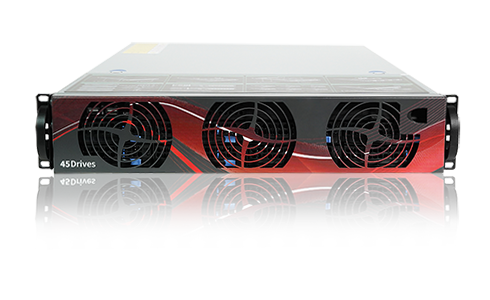
Storinator 4U Top-loading Server

Storinator 2U Front-loading Server
What is Enterprise Network Attached Storage
An enterprise network-attached storage (NAS) server, is a device that is connected to your
computer, which serves as a central location for data storage. You could require a NAS if you
run out of storage on your desktop or if you know you are going to need a large amount of
storage in the future. A NAS is connected to the Ethernet port on your network and will show up
the same as a single drive on your computer. This enables multiple computers on a network to
share and access files, stream video and audio, and backup data from one central device. It also
has more storage than a single drive - up to hundreds of terabytes.
Our NAS solution includes a storage server (Storinator), one or more hard drives, a processor,
RAM – and an opensource software of your choice for your Operating System (OS) which manages
access and your network connection.
Our network attached storage server is great for any business size from the enterprise to the
small business to boost productivity and minimize IT overhead. It also has the ability to
scale-out when more storage is needed. You even have the ability to link together multiple NAS
servers to a scale-out cluster, with the ability to
achieve petabytes of storage.

What are the benefits of a Storinator network attached storage server?
- Affordable large storage
- Keep all your files in one centralized location
- Easy to set up and configured by our 45Drives Engineers
- Remote access available through Intelligent Platform Management Interface (IPMI) and Nextcloud.
- File sharing with multiple users
- Backup multiple computers within your network automatically
- Provides hard-drive RAID redundancy to protect your data
- Set up user permissions, folder privileges and restrict access to documents
- Available in 4, 8, 15,30,45 and 60 drive configurations
- Compatible with Dropbox, Dropbox Business, Amazon S3, and Microsoft Azure

How do I configure a NAS server?
A 45Drives storage engineer will set-up your network attached storage according to your needs,
so your server will be properly configured, fully-functional and ready to go when it arrives at
your door. If you would rather wait until your server arrives at your location one of our
Support Engineers will walk you through the configuration so you will have the best knowledge to
maintain your new storage server.
A 45Drives Engineer will take the following steps:
- Arrange a consultation phone call with you to discuss your needs.
- Setup your preferred RAID array and filesystem on the OS of your choice
- Network configuration (Network information required)
- Setup Users and Groups (User information required)
- Share configuration (NFS, AFP, SMB)
- Configure for disaster recovery
- Ceph install and configuration
If you choose NOT to have 45Drives configure your server, you will still receive a fully
assembled and tested Storinator pre-loaded with your chosen OS.

What networking speed should I be running?
Consider your current network infrastructure and what speed networking it supports, as you
may need to factor upgrading switches and cables into the cost of a NIC upgrade. Often
clients with multiple video editors working directly off their NAS choose to upgrade their
networking to at least 10GbE because it will easily be saturated. Fiber is also an option
for those that want the fastest possible speeds.
What if I need more storage?
Our network attached storage server is great for any size organization. From the enterprise
business to the small business a NAS can boost productivity and minimize IT overhead. It
also has the ability to scale-out when more storage is needed. You even have the ability to
link together multiple NAS servers to a single unit
scale-out cluster, with the ability to achieve petabytes of storage.
What can I store on a network attached storage server?
You can store both large and small files, our network attached storage server is great
for any business size from the small business to enterprise companies looking to store
data, boost productivity and minimize IT overhead.
How much storage space do I need?

Think about your current storage capacity. At what rate is your storage server filling
now and how much is that rate increasing?
Think about the timeframe you want to purchase storage for. With all this information
you should be able to determine what useable capacity you’ll need over the lifetime of
your NAS.
Please note: When we talk about raw capacity, we mean the
capacity of the Network Attached Storage (NAS) plus the number of hard drives,
multiplied by the size of the hard drive. For example, if you have a Storinator S45
populated with 10TB drives that gives you 450TB of raw storage.
It’s important to remember that the useable capacity of the NAS is less than the raw
capacity. The useable capacity is affected by things like RAID level and which operating
system (OS) you use. Which leads to another question you will want to ask yourself.
What RAID level do I need?
RAID 0
Has no effect on useable capacity and the highest
performance of any RAID level. But if one drive is lost the entire RAID will
fail.
RAID 1
50% of raw capacity is lost to redundancy. You
won’t lose any data unless you lose both drives from a mirrored pair.
RAID 10
50% of raw capacity lost to redundancy. Faster
than just a RAID 1 but if you lose two drives from the same mirror then the
entire pool is lost instead of just the contents of one drive.
RAID 5 or 50
1 drive worth of raw capacity is lost to
redundancy per RAID 5 array. The pool will still be able to rebuild if you lose
one drive but is very vulnerable during rebuild. RAID 5 is slower than RAID 0.
RAID 6 or 60
2 drives worth of raw capacity is lost to
redundancy per RAID 6. You can withstand two drive failures per array. Slower
but considered by many to be a good trade-off with a RAID 10 for the increased
space efficiency and strong redundancy.
The decision between different RAID levels will be a choice between
these attributes:
✓ Storage
efficiency
✓ Performance
✓ Redundancy
✓ Rebuild
times/safety
✓
Cost-effectiveness
Build and
Price:
FRONT-LOADING
TOP-LOADING






